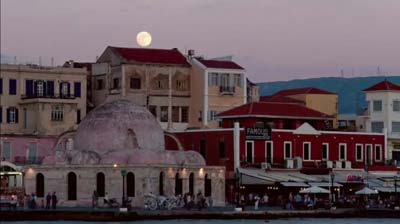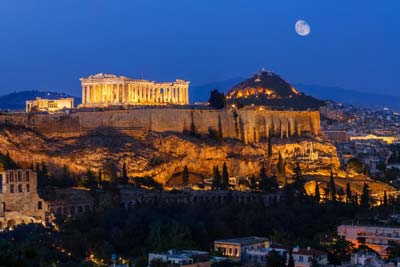Greece beckons with its wide open skies and miles of aquamarine coastline, and then it draws you in with its ancient sights, slow-paced island life and vibrant, multicultural cities. Remarkable archaeological sights often take the limelight, but it’s just as easy to find traditional villages with brilliant sugar-cube houses and roaming donkeys, while Athens’ firm grip on style and sophistication rivals that of any European capital.

Acropolis lit up at night. Image courtesy of the Region of Attica
Experiencing the Acropolis
There’s a reason Acropolis remains the quintessential landmark of Western civilisation – it is spectacular. Standing sentinel over Athens, its marble monuments gleam white in the midday sun while at night they are brilliantly illuminated above the city. A glimpse of this magnificent sight cannot fail to lift your spirits: whether experienced during an early morning stroll up its flanks or from a dinnertime terrace with the Parthenon all lit up and glorious, the Acropolis embodies a harmony, power and beauty that speak to all generations. Look beyond the Parthenon and you’ll find more intimate spots such as the exquisite, tiny Temple of Athena Nike, while the Acropolis Museum cleverly showcases the ethereal grace of the Acropolis’ surviving treasures.

The famous Santorini sunset. Image by Hanquan Chen / Getty Images
Santorini sunsets
Even the most jaded traveller succumbs to the spectacle of the surreal landscape of Santorini (Thira), a relic of what was probably the biggest eruption in recorded history – the caldera and its vast curtain of multicoloured cliffs is truly awesome. The island is famous for its spectacular sunsets, hugely popular from the village of Oia on its northern tip because there is an uninterrupted view of the sun as it finally sinks below the horizon. On summer evenings the clifftop town is packed with visitors awed by the vast blood-red canvas of the cliff face as the sun struts its stuff. You can catch the sunset without the crowds from almost anywhere along the cliff edge. And if you miss sundown, you can always face east at first light for some fairly stunning sunrises too.

Soaring rock pinnacles at Meteora. Image by Alexis Averbuck / Lonely Planet
Soaring high at Meteora
You’re not likely to forget the first moment the magnificent Meteora comes into view – soaring pillars of rock that jut heavenward, and a handful of monasteries at the summit (some dating from the 14th century). Once, these monasteries were used successfully as refuge by hermit monks seeking a retreat from expanding Turkish occupation. The rope ladders which once enabled the monks to reach the top have long been replaced by steps carved into the rock. Today, these spectacular stone towers beckon rock climbers from around the world.

Historic main square in Rhodes’ Old Town. Image by Matt Munro / Lonely Planet
Rhodes’ medieval Old Town
Getting lost in Rhodes’ Old Town is a must. Away from the crowds, meander down twisting, turning, cobbled alleyways with archways above and squares opening up ahead of you. In these hidden corners the imagination takes off with flights of medieval fancy. Explore the ancient Knights’ Quarter, the old Jewish neighbourhood or the Turkish Quarter. Hear traditional live music in tiny tavernas or dine on fresh seafood at atmospheric outdoor restaurants. Wander along the top of the city walls, with the sea on one side and a bird’s-eye view into this living museum.

Crete’s stunning Preveli Beach. Image by Bruno Morandi / Getty Images
Crete’s palm-lined Preveli Beach
Crete’s stunning Preveli Beach (aka Palm Beach) comprises one of Greece’s most instantly recognisable stretches of sand. Bisected by a freshwater river and flanked by cliffs concealing sea caves, Preveli is lapped by the Libyan Sea, with clear pools of water along its palm-lined riverbank which are perfect for cool dips. The beach lies under the sacred gaze of a magnificent monastery perched high above. Once the centre of anti-Ottoman resistance and later a shelter for Allied soldiers, this tranquil place offers knockout views.
Source: lonelyplanet.com









































